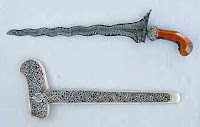 |
| Keris Stabbing Weapon Indonesia |
 |
| Keris & Wrangka |
The utilising of Keris is different in each region. In Java and Sunda for examples, they slip Keris in the backside of their waist on peaceful situation and move it to the frontside when war begun. While in Sumatra, kalimantan, Malaysia, Brunei, and Philippines, Keris is placed in front.
 |
| Keris handle |
Wrangka or Keris cover is a component that has special function especially in social interacts between people in Java, at least this is the only part that seen directly. Wrangka at first was made from wood ( commonly oak wood, sandalwood, timoho, and kemuning). Along with the development, wrangka has an additional function as a reflection of its owner's social status. The upper part is commonly changed with ivory. Briefly, there are two types of wrangka :
* Wrangka Ladrang consists of : angkup, lata, janggut, gandek, godong ( in the leaf form ),gandar, ri,and cangkring.
* Wrangka Gayaman (gandon) consists of the same part as wrangka ladrang but without angkup, godong, and gandek.
 |
| Utilising of Keris is by slipping |
with the purpose of respect. The utilising of Keris is by slipping it in the foldaway side of belt ( stagen) in the backside (waist ). In war Keris wrangka ladrang is used, its because wrangka ladrang is practical and its simple form made people easier to use it. Ladrang and gayaman are form pattern wrangka and their important part is the bottom side that shaped rectangle ( along the wilah Keris ) and called as gandar or antupan, thus the gandar's function is to cover wilah (blade) and usually made from wood (so it won't ruin the wilah that made from metal mixture). As its covering function, the aesthetic of a gandar isn't priority, to make more beautiful, gandar will coated with cylinder cartridge called Pendok. This pendok part is usually beautifully carved, made from metal brass, suasa (mixture between gold and copper), silver and gold. In other region beside Java (Bugis,Goa,Palembang,Riau,Bali) the Pendok is made from gold and decorated with gold embroidery and flowers that scattered with diamonds. Keris in Java, according to its form can divided into :
 |
| Pendok |
2. Pendok blewah (blengah) slide longitudinal into the other side and that makes the Gandar seen.
3. Pendok topengan which the slide is placed only in the front part.
By its decor, Pendok can be categorized Luk, Luk is the curve part of a Keris and from its form, Keris can divided into two category :
1. Keris with a straight blade.
2. Keris with a curve blade.
 |
| Keris Straight Blade |
Keris and Wayang become awfully fantastic Indonesia's Intangible Heritage that have been and will be recognized by UNESCO. Masterpiece of the Oral and Intangible Heritage of Humanity.


Tidak ada komentar:
Posting Komentar